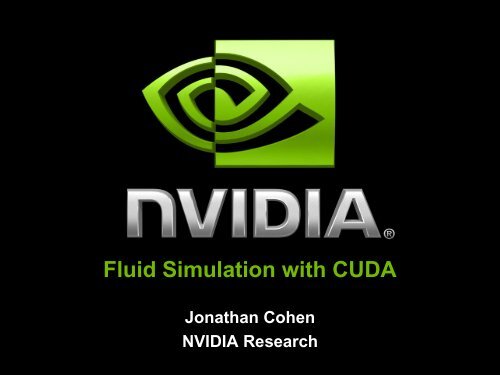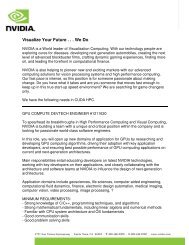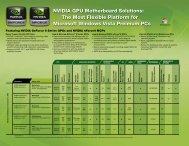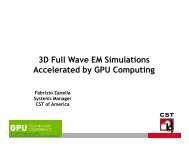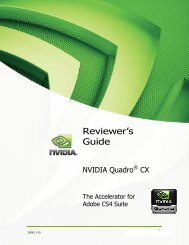Fluid Simulation with CUDA
Fluid Simulation with CUDA
Fluid Simulation with CUDA
You also want an ePaper? Increase the reach of your titles
YUMPU automatically turns print PDFs into web optimized ePapers that Google loves.
<strong>Fluid</strong> <strong>Simulation</strong> <strong>with</strong> <strong>CUDA</strong><br />
Jonathan Cohen<br />
NVIDIA Research
CFD Code Design Considerations<br />
Legacy CFD codes in wide use<br />
CFD community is cautiously exploring GPU computing<br />
Major issue: How to handle legacy code?<br />
Accelerate vs. Rewrite?<br />
Is it worth it?<br />
What about other approaches we may have completely<br />
missed? Rethink numerical methods?<br />
© NVIDIA Corporation 2009
Conceptual Map of CFD on <strong>CUDA</strong><br />
Option 1: “Accelerate” existing code<br />
Option 2: Write new code from scratch<br />
Option 3: Rethink numerical methods<br />
Fermi results not available as of press time.<br />
[Notes in yellow indicate differences.]<br />
© NVIDIA Corporation 2009
Option 1: “Accelerator” Design<br />
Case Study: FEAST from TU Dortmund<br />
Finite Element Analysis and Solution Tools<br />
Complex FE code for CFD and Structural Mechanics<br />
Dominik Göddeke et al. accelerated using GPUs<br />
Their approach: High level of abstraction<br />
© NVIDIA Corporation 2009<br />
Minimally invasive co-processor integration<br />
Identify and isolate "accelerable" parts of a computation<br />
Chunks must be large enough to amortise co-processor<br />
drawbacks<br />
Portions of this slide courtesy Dominik Göddeke
FEAST-GPU Design Philosophy<br />
FEAST-GPU Goal:<br />
Integrate several coprocessors<br />
into existing<br />
large-scale software<br />
package...<br />
...<strong>with</strong>out modifying<br />
application code<br />
NOT mapping single<br />
application to GPU / GPU<br />
Cluster<br />
Balance acceleration potential<br />
and acceleration effort<br />
© NVIDIA Corporation 2009<br />
Portions of this slide courtesy Dominik Göddeke
FEAST-GPU Integration Results<br />
Opteron 2214, 4 nodes<br />
GeForce 8800 GTX<br />
<strong>CUDA</strong> backend<br />
18.8 M DOF<br />
Accel. fraction R acc: 75%<br />
Local speedup S local: 11.5x<br />
Theoretical limit S max: 4x<br />
Global speedup S total: 3.8x<br />
© NVIDIA Corporation 2009<br />
Portions of this slide courtesy Dominik Göddeke
Option 2: Rewrite<br />
If you were to attempt a rewrite:<br />
© NVIDIA Corporation 2009<br />
What is a good overall design?<br />
What global optimizations are possible?<br />
What total application speedup can you get?<br />
How does rewrite compare to “accelerator” design?<br />
Does 10x improvement on bottlenecks translate into<br />
10x improvement for entire system?<br />
Challenge: Need a “fair” benchmark for comparison
OpenCurrent<br />
Open Source, written by Jonathan Cohen<br />
http://code.google.com/p/opencurrent/<br />
© NVIDIA Corporation 2009<br />
Applications Unit Tests<br />
Equations<br />
Solvers<br />
Storage
Global Optimizations<br />
No serial bottlenecks (except IO)<br />
No unnecessary PCI-express transfers<br />
Small problems run on CPU<br />
Use of on-chip caches [Less important <strong>with</strong> Fermi]<br />
3D array layout for maximum coalescing<br />
Congruent padding<br />
© NVIDIA Corporation 2009
Review: Memory Coalescing<br />
512-bit memory interface = 16 words per memclk<br />
Coalescer tries to batch simultaneous memory<br />
transactions into small number of 16 word batches<br />
Threads <strong>with</strong>in half-warp loading bytes <strong>with</strong>in<br />
[baseAddr, baseAddr + 16]<br />
coalesced to single wide load<br />
E.g. this will be optimal:<br />
idx = blockIdx.x * blockDim.x + threadIdx.x;<br />
float x = global_array[idx];<br />
Up to 16x performance boost for memory-bound<br />
applications<br />
© NVIDIA Corporation 2009
Layout of 3D Array<br />
baseptr<br />
“Pre-padding” so z=0 starts at 16-word boundary<br />
Pad each row to multiple of 16 words<br />
© NVIDIA Corporation 2009
Optimal coalescing when each thread accesses<br />
corresponding array element:<br />
© NVIDIA Corporation 2009<br />
__global__ void Process3DArray(<br />
double *baseptr,<br />
int xstride,<br />
int ystride,<br />
...<br />
int blocksInY)<br />
{<br />
unsigned int blockIdxz = blockIdx.y / blocksInY;<br />
unsigned int blockIdxy = blockIdx.y % blocksInY;<br />
unsigned int i = blockIdxz *blockDim.z + threadIdx.z;<br />
unsigned int j = blockIdxy *blockDim.y + threadIdx.y;<br />
unsigned int k = blockIdx.x*blockDim.x + threadIdx.x;<br />
}<br />
int idx = i*xstride + j*ystride + k;<br />
// This will be optimally coalesced:<br />
double T_ijk = baseptr[idx];<br />
...
Index Translation – The Problem<br />
Grids may naturally have different dimensions<br />
E.g. for staggered u,v,w grids on 32 x 32 x 32 mesh,<br />
u = 33 x 32 x 32<br />
© NVIDIA Corporation 2009<br />
v = 32 x 33 x 32<br />
w = 32 x 32 x 33<br />
Translate from (i,j,k) to memory location:<br />
ptr = base_ptr + i * ny * nz + j * nz + k;<br />
Since nx, ny, nz are different for u,v,w, must calculate &<br />
store ptr 3 times per element<br />
Serial code could calculate offsets for previous cells<br />
1 thread/element => offsets won’t work<br />
Cost of extra per-thread calculation & state adds up <strong>with</strong><br />
millions of threads
Optimization: Congruent Padding<br />
Grid A is congruent to Grid B iff<br />
For all i,j,k:<br />
(&A[i,j,k] – &A[0,0,0]) = (&B[i,j,k] – &B[0,0,0])<br />
Pad nx, ny, nz to enforce congruency<br />
Also pad for memory alignment, ghost cells, etc.<br />
-1,2<br />
18<br />
-1,1<br />
12<br />
-1,0<br />
6<br />
-1,-1<br />
0<br />
0,2<br />
19<br />
0,1<br />
13<br />
0,0<br />
7<br />
0,-1<br />
1<br />
© NVIDIA Corporation 2009<br />
1,2<br />
20<br />
1,1<br />
14<br />
1,0<br />
8<br />
1,-1<br />
2<br />
2,2<br />
21<br />
2,1<br />
15<br />
2,0<br />
9<br />
2,-1<br />
3<br />
Pad<br />
22<br />
Pad<br />
16<br />
Pad<br />
10<br />
Pad<br />
4<br />
Pad<br />
23<br />
Pad<br />
17<br />
Pad<br />
11<br />
Pad<br />
5<br />
-1,2<br />
18<br />
-1,1<br />
12<br />
-1,0<br />
6<br />
-1,-1<br />
0<br />
0,2<br />
19<br />
0,1<br />
13<br />
0,0<br />
7<br />
0,-1<br />
1<br />
1,2<br />
20<br />
1,1<br />
14<br />
1,0<br />
8<br />
1,-1<br />
2<br />
2,2<br />
21<br />
2,1<br />
15<br />
2,0<br />
9<br />
2,-1<br />
3<br />
3,2<br />
22<br />
3,1<br />
16<br />
3,0<br />
10<br />
3,-1<br />
4<br />
4,2<br />
23<br />
4,1<br />
17<br />
4,0<br />
11<br />
4,-1<br />
5
Congruent Padding - Results<br />
Passive Advection<br />
© NVIDIA Corporation 2009<br />
16 registers => 13 registers<br />
132 instructions => 116 instructions (12%)<br />
Restrict Residual (multigrid)<br />
14 registers => 13 registers<br />
75 instructions => 68 instructions (9%)<br />
Self-advection<br />
46 registers => 43 registers<br />
302 instructions => 264 instructions (13%)
Benchmark: Rayleigh-Bénard<br />
Convection<br />
INITIAL<br />
TEMPERATURE<br />
© NVIDIA Corporation 2009<br />
COLD<br />
HOT<br />
CIRCULATING<br />
CELLS
Rayleigh-Bénard Details<br />
Double precision, second order accurate<br />
384 x 384 x 192 grid (max that fits in 4GB)<br />
Transition from stratified (left) to turbulent (right)<br />
Validated critical Rayleigh number against theory<br />
Validated / benchmarked more complex problems<br />
against published results & Fortran code<br />
© NVIDIA Corporation 2009
Benchmark Methodology<br />
Fortran code<br />
© NVIDIA Corporation 2009<br />
Written by Jeroen Molemaker @ UCLA<br />
8 Threads (via MPI and OpenMP) on 8-core 2.5 GHz Xeon<br />
Several oceanography pubs using this code, ~10 years of<br />
code optimizations. Code is small & fast.<br />
Per-step calculation time varies due to convergence<br />
rate of pressure solver<br />
Record time once # of v-cycles stabilizes<br />
Point relaxer on GPU – 1 FMG + 7 v-cycles<br />
Line relaxer on CPU – 1 FMG + 13 v-cycles
Benchmark Results<br />
<strong>CUDA</strong> (1 Tesla C1060) vs. Fortran (8-core 2.5 GHz Xeon)<br />
As “apples-to-apples” as possible ($ and manpower)<br />
© NVIDIA Corporation 2009<br />
Equal price nodes (~$3k)<br />
Skilled programmers in each paradigm<br />
Resolution <strong>CUDA</strong><br />
time/step<br />
Fortran<br />
time/step<br />
Speedup<br />
64 x 64 x 32 24 ms 47 ms 2.0x<br />
128 x 128 x 64 79 ms 327 ms 4.1x<br />
256 x 256 x 128 498 ms 4070 ms 8.2x<br />
384 x 384 x 192 1616 ms 13670 ms 8.5x
Single Precision vs Double Precision<br />
Identical simulation, only difference is precision of<br />
buffers & math routines<br />
fp64 incurs penalty of 46% - 68% (far less than 12x)<br />
[Fermi fp64 results are different]<br />
Resolution fp64<br />
© NVIDIA Corporation 2009<br />
time/step<br />
fp32<br />
time/step<br />
Ratio<br />
64 3 0.020912 0.014367 1.46x<br />
128 3 0.077741 0.046394 1.68x<br />
256 3 0.642961 0.387173 1.66x
Related Work: GIN3D<br />
GIN3D: GPU accelerated Incompressible Navier-Stokes 3D<br />
solver for emerging massively parallel multi-GPU clusters<br />
© NVIDIA Corporation 2009<br />
From Dana Jacobsen and İnanç Şenocak @ Boise State<br />
Lid Driven<br />
Cavity<br />
Velocity magnitude<br />
Heated Cavity<br />
Temperature<br />
GIN3D <strong>Simulation</strong> Capabilities<br />
Rayleigh-Bénard Convection<br />
Temperature Field, Pr = 12.5, Ra = 0.35<br />
Flow in Urban<br />
Environments<br />
Portions of this slide courtesy Dana Jacobsen
GIN3D: Combining <strong>CUDA</strong> <strong>with</strong> MPI<br />
NCSA Lincoln Cluster: 32 nodes, 64 GPUs<br />
Staggered uniform grid, 2 nd order in time and space<br />
MPI exchange interleaved <strong>with</strong> <strong>CUDA</strong> kernels<br />
© NVIDIA Corporation 2009<br />
for (t = 1 .. nTimesteps) {<br />
temperature(u,v,w,phi)<br />
Copy_Exchange_Ghost_Cells(phi)<br />
momentum>(u,v,w,phi)<br />
Copy_Exchange_Ghost_Cells(u,v,w)<br />
divergence>(u,v,w,div)<br />
for (n = 1 .. nIterations) {<br />
pressure>(div,p)<br />
Copy_Exchange_Ghost_Cells(p)<br />
}<br />
velocity_correct> (u,v,w,p)<br />
Copy_Exchange_Ghost_Cells(u,v,w)<br />
}<br />
Portions of this slide courtesy Dana Jacobsen
Overlap MPI <strong>with</strong> <strong>CUDA</strong><br />
© NVIDIA Corporation 2009<br />
Host (CPU)<br />
MPI_ISEND<br />
MPI_ISEND<br />
MPI_IRECV<br />
MPI_IRECV<br />
Host (CPU)<br />
Portions of this slide courtesy Dana Jacobsen<br />
MPI_ISEND<br />
MPI_ISEND<br />
MPI_ISEND<br />
MPI_ISEND<br />
MPI_IRECV<br />
MPI_IRECV<br />
MPI_IRECV<br />
MPI_IRECV<br />
Copy<br />
Copy<br />
Copy<br />
Copy<br />
Copy<br />
Copy<br />
Copy<br />
Copy<br />
GPU GPU # # NN<br />
GPU GPU # # N-1 N-1<br />
Top Top Middle Middle Bottom Bottom<br />
Top Top Middle Middle Bottom Bottom
Strong Scaling: 1024x64x1024 Grid<br />
Speedup (x)<br />
140.0<br />
120.0<br />
100.0<br />
80.0<br />
60.0<br />
40.0<br />
20.0<br />
0.0<br />
8.7<br />
8.6<br />
© NVIDIA Corporation 2009<br />
100% 98%<br />
100%<br />
8.6<br />
95%<br />
16.4 16.9 17.0<br />
86%<br />
78%<br />
27.2 28.9 29.7<br />
42.9<br />
79%<br />
62%<br />
52.6<br />
54.8<br />
65.9<br />
70%<br />
88.9<br />
47%<br />
96.3<br />
90.0<br />
113<br />
40%<br />
32%<br />
1 2 4 8 16 32 64<br />
Number of GPUs<br />
111<br />
110<br />
125 123<br />
22%<br />
20%<br />
100%<br />
GPU Speedup relative 8 cores (non-overlapped) GPU Speedup relative 8 cores (overlapped)<br />
GPU Speedup relative 8 cores (streams overlapped) GPU Cluster effficiency (non-overlapped)<br />
GPU Cluster effficiency (overlapped) GPU Cluster effficiency (streams overlapped)<br />
Portions of this slide courtesy Dana Jacobsen<br />
90%<br />
80%<br />
70%<br />
60%<br />
50%<br />
40%<br />
30%<br />
20%<br />
10%<br />
0%<br />
Efficiency
Efficiency<br />
Weak Scaling: 3.8 GB per GPU<br />
1.0<br />
0.8<br />
0.6<br />
0.4<br />
0.2<br />
0.0<br />
1.00<br />
© NVIDIA Corporation 2009<br />
1.02<br />
0.84<br />
0.83<br />
0.47<br />
0.88<br />
0.86 0.84<br />
0.47<br />
1 2 4 8 16 32 64<br />
Number of GPUs<br />
0.88<br />
0.46<br />
Efficiency (non-overlapped) Efficiency (overlapped)<br />
Efficiency (streams overlapped) Perfect scaling<br />
0.85<br />
0.80<br />
0.43<br />
Portions of this slide courtesy Dana Jacobsen<br />
0.82<br />
0.75<br />
0.40<br />
1.35 TeraFLOPS<br />
Overlapping<br />
computation<br />
is critical!<br />
0.66 TeraFLOPS
Option 3: Rethink the Numerics<br />
Numerical methods have co-evolved <strong>with</strong><br />
programming languages, compilers, & architectures<br />
© NVIDIA Corporation 2009<br />
Not coincidental that popular methods are easy to express<br />
in popular languages<br />
Maybe new (parallel) architectures require new<br />
numerics?<br />
Find methods that inherently map well to GPUs<br />
Maybe we overlooked something in the past because it<br />
was impractical
Example: Nodal Discontinuous<br />
Galerkin Methods<br />
Work from Andreas Klöckner et al @ Brown & Rice<br />
Solve conservation laws over unstructured grids<br />
DG on GPUs: Why?<br />
© NVIDIA Corporation 2009<br />
u t + ∙F(u) = 0<br />
GPUs have deep memory hierarchy<br />
The majority of DG is local.<br />
Compute Bandwidth >> Memory Bandwidth<br />
DG is arithmetically intense.<br />
GPUs favor dense data.<br />
Local parts of the DG operator are dense.<br />
Portions of this slide courtesy Andreas Klöckner
DG Results – Single GPU<br />
© NVIDIA Corporation 2009<br />
Nvidia GTX280 vs. single core of Intel E8400<br />
Maxwell’s Equations<br />
Portions of this slide courtesy Andreas Klöckner
DG Results – GPU Cluster<br />
© NVIDIA Corporation 2009<br />
16 T10s vs. 64 Xeon E5472<br />
Portions of this slide courtesy Andreas Klöckner
Conclusion: Three Options<br />
“Accelerate” Legacy Codes<br />
© NVIDIA Corporation 2009<br />
Appropriate in some cost/benefit regime<br />
Rewrite From Scratch<br />
Worth it for many applications<br />
Double Precision performance is pretty good, getting<br />
better<br />
Rethink Numerical Methods<br />
Potential for biggest performance advantage<br />
Exciting time to be computational scientist!
Thanks<br />
Andreas Klöckner<br />
Dominik Göddeke<br />
Dana Jacobsen<br />
Jeroen Molemaker<br />
© NVIDIA Corporation 2009
Cited Work<br />
GIN3D<br />
Jacobsen, D. and Senocak, I. “Massively Parallel Incompressible<br />
Navier-Stokes Computations on the NCSA Lincoln Tesla<br />
Cluster,” GPU Technology Conference, 2009.<br />
Thibault, J. and Senocak, I. “<strong>CUDA</strong> Implementation of a Navier-<br />
Stokes Solver on Multi-GPU Desktop Platforms for<br />
Incompressible Flows,” 47th AIAA Aerospace Sciences Meeting,<br />
paper no: AIAA-2009-758, 2009.<br />
Nodal DG Methods<br />
Andreas Klöckner, Tim Warburton, Jeff Bridge, Jan Hesthaven,<br />
“Nodal Discontinuous Galerkin Methods on Graphics<br />
Processors,” J. of Comp. Physics 2009.<br />
FEAST-GPU<br />
http://www.feast.uni-dortmund.de/publications.html<br />
© NVIDIA Corporation 2009
For more info<br />
OpenCurrent<br />
http://code.google.com/p/opencurrent/<br />
J. Cohen and M. Molemaker, “A Fast Double Precision CFD<br />
Code using <strong>CUDA</strong>,” Proceedings of ParCFD 2009.<br />
CFD applications in <strong>CUDA</strong><br />
http://www.nvidia.com/object/computational_fluid_dynamics.html<br />
NVIDIA Research<br />
http://www.nvidia.com/research<br />
© NVIDIA Corporation 2009


